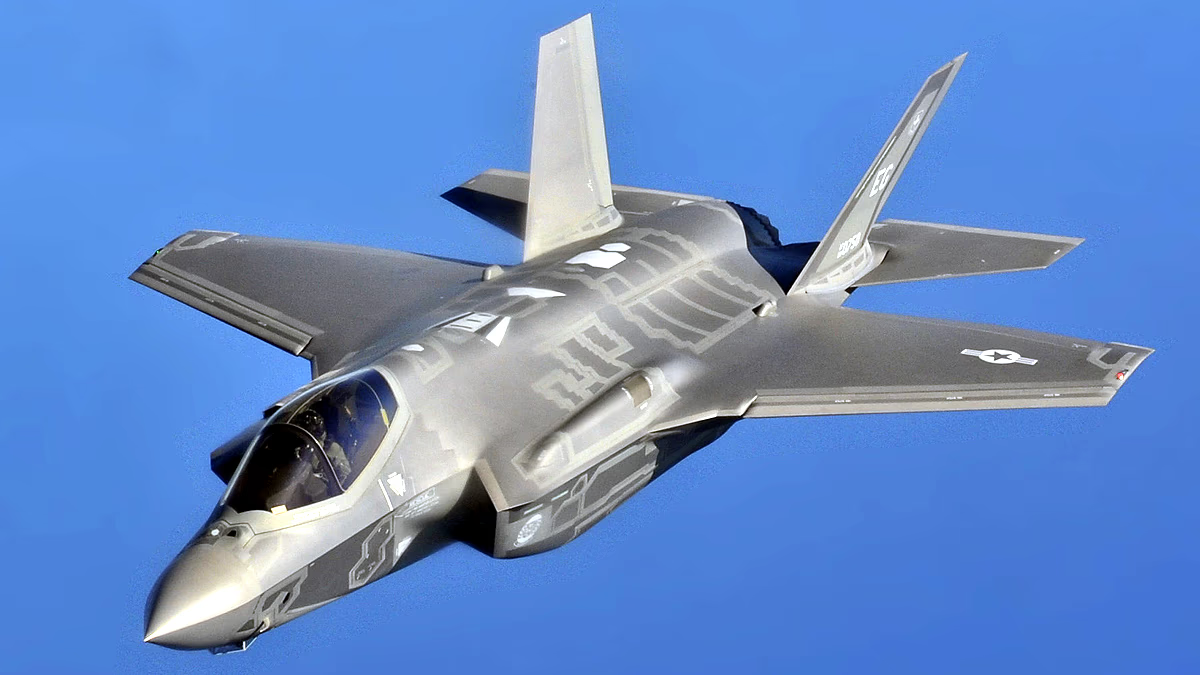Escalating tensions between Israel and Iran have spotlighted Israel's cutting-edge military capabilities, particularly following the initiation of Operation Rising Lion on June 13, 2025. Israel's strategic attacks have targeted Iran's nuclear facilities, military bases, and leadership, resulting in over 400 casualties.
Iran's retaliatory missile and drone strikes were largely ineffective, highlighting vulnerabilities in its defense systems. Here's a closer look at Israel's five most powerful weapons, their capabilities, and how Iran's defense weaknesses have facilitated effective strikes on Tehran and other Iranian cities.
Five Unstoppable Israeli Weapons
Israel's armory, supported by advanced technology and U.S. collaboration, includes precision, stealth, and powerful targeting weapons. These are the key instruments in Israel's offensive arsenal...
F-35I 'Adir' Stealth Fighter Jet

Source: aajtak
The F-35I, a variant of the U.S. F-35 Lightning II, is a stealth multirole fighter, equipped with advanced electronic warfare systems, sensor fusion, and a helmet-mounted display. It boasts a range of 2,200 km, a top speed of Mach 1.6, and a payload capacity of up to 8,160 kg. This includes Israeli Spice precision-guided bombs.
Over 200 F-35I jets have struck over 100 targets in Iran, including Natanz and Fordow nuclear sites. Their stealth capability has evaded Iranian radar, enabling precision hits on underground centrifuge halls and military command centers, thus allowing Israel to achieve air dominance over Tehran without risk.
GBU-39/B Small Diameter Bomb (SDB)

Source: aajtak
This 250-pound precision-guided glide bomb, with a 110 km range, utilizes GPS/INS guidance and can penetrate up to 3 feet of reinforced concrete. Its compact size allows F-16s and F-35s to carry multiple bombs.
These bombs have targeted missile launchers, nuclear research centers, and command hubs, devastating the upper structure of Natanz. Their accuracy rendered Iran's limited air defenses ineffective, destroying key infrastructure with minimal collateral damage.
Jericho-3 Ballistic Missile

Source: aajtak
Jericho-3 is an intermediate-range ballistic missile (IRBM) with a range of 4,800–6,500 km and capable of carrying a payload of 1,000–1,300 kg of conventional or nuclear warheads (Israel is estimated to possess around 90 nuclear weapons). It employs inertial and potentially GPS guidance.
Though its usage during the June 2025 strikes remains uncertain, Jericho-3's range poses a threat to cities like Tehran, Isfahan, and Shiraz, capable of striking military and nuclear sites with conventional warheads. Its presence compelled Iran to spread its defenses, due to its capability for low-warning attacks.
Spike Anti-Tank Missile

Source: aajtak
Spike missiles, including non-line-of-sight (NLOS) models with a 30 km range, use electro-optical and infrared guidance. They can be launched from vehicles, helicopters, or drones and feature tandem warheads to penetrate armored targets.
They were crucial in eliminating IRGC Commander Hossein Salami, Chief of Staff Mohammad Bagheri, and nine nuclear scientists. Launched from drones and ground platforms, these precise strikes disrupted Iran's military leadership, hindering coordinated responses.
Heron TP Unmanned Aerial Vehicle (UAV)

Source: aajtak
The Heron TP is a long-endurance drone with a 26-meter wingspan, a maximum altitude of 45,000 feet, and over 30 hours of flight capability. It carries up to 1,000 kg of payload, such as surveillance equipment and Anchor missiles. The Heron TP has conducted surveillance and precision strikes within Iranian airspace.
It was instrumental in destroying mobile missile launchers and provided real-time intelligence to F-35Is. Israel established drone bases near Tehran, maintaining pressure on Iran and interrupting missile activities.
Weaknesses in Iran's Defense
The June 2025 strikes revealed several weaknesses in Iran's defense systems...
Outdated Air Defense Systems
Iran relies on Russian S-300, locally developed Bavar-373, and outdated Soviet-era systems. Israel destroyed four S-300 systems, including one near Natanz. These systems are ineffective against Israel's stealth aircraft and smaller munitions like the GBU-39/B. Iran's short-range missiles pose limited threats, allowing Israel to achieve air superiority and attack defense ministries and nuclear sites.
Weak Air Force
Iran's fleet counts 312 outdated combat aircraft (pre-1979 U.S. or Soviet models) and 57 helicopters, unable to compete with Israel's 345 modern aircraft, like F-35 and F-16. Iranian jets did not challenge Israeli air dominance, enabling unimpeded strikes on Tehran, Isfahan, Shiraz, and Tabriz.

Source: aajtak
Inadequately Secured Nuclear Sites
Although fortified, Iran's nuclear sites, like Natanz and Fordow, are not fully secure. Natanz's upper part was destroyed, and power outages damaged centrifuges. Fordow, located in a mountain, remains vulnerable to U.S. GBU-57 bunker busters. Israel's intelligence enabled precise targeting of critical elements. Damages to Natanz and Isfahan have setback Iran's nuclear program.
Missile Stockpile Vulnerabilities
Iran has approximately 3,000 ballistic missiles, 2,000 of which can reach Israel. However, Israel destroyed one-third of the mobile launchers. Israel's Iron Dome, David's Sling, and Arrow systems intercepted most missiles and drones, with only a few reaching Tel Aviv and Haifa. Iran's retaliatory efforts were limited, allowing Israel to sustain its offensive.
Fractured Command Structure
Israel's strikes eliminated IRGC Commander Hossein Salami, Chief of Staff Mohammad Bagheri, and several scientists, weakening Iran's coordination capabilities. Internal political pressures complicated decision-making processes, leading to disorganized retaliation attempts and providing Israel a strategic advantage.

Source: aajtak
Iran’s Response Challenges
Iran launched over 100 missiles and drones, resulting in 14 Israeli casualties. However, these efforts proved largely ineffective...
High interception rate: Israel’s Iron Dome and Arrow, along with American Patriot and THAAD systems, intercepted most projectiles.
Reduced capabilities: Israel’s strikes devastated Iranian launchers and air defenses.
Proxy weakness: Proxies like Hezbollah and Hamas have shown diminished effectiveness.
Reason for Strikes on Tehran and Other Cities
Tehran, Isfahan, Shiraz, and Tabriz were targeted due to these strategic factors...
Geographic vulnerability: Iran’s large size makes protecting all cities challenging. Israel’s long-range missiles and jets can strike anywhere.
Urban weaknesses: Attacks on urban areas, oil depots (such as Sharhan), and government buildings have instilled fear among civilians.
Intelligence superiority: Israel’s Mossad-supported intelligence has facilitated precision strikes.




